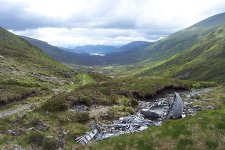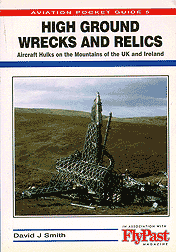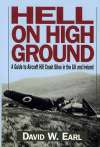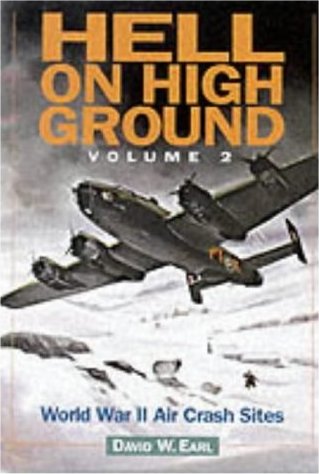 Back to Home Page
Back to Home Page
Aircraft Wreckage Sites in the Scottish Mountains
Note: this page has now moved to
http://www.edwardboyle.com/airwrecks_new.html.
Please update your bookmarks.
Last update: May 2008
The mountainous and wild areas of Scotland have an unusual, little known, and some might say slightly macabre feature; namely the
wreckage of many aircraft that have crashed and have, because of their location, never been wholly removed.
These wreck sites vary hugely in the amount of aircraft debris left behind and in their accessibilty. They also represent the sites where
many airmen have died, and while in some cases the location is marked by a memorial, in most all that remains is twisted and
weather-bleached metal. Indeed, perhaps another reason that this wreckage has remained uncollected by the relevant authorities (whether
military or civilian) is to provide a sort of lasting marker to the deaths of the pilots and crew involved. It should of course be noted that
removing pieces of wreckage from any of these sites without good reason (e.g. as trophies or souvenirs) is a deeply irresponsible thing
to do.
The incongruity of finding crashed aircraft in the Scottish mountains is hard to exaggerate; in wild, barren landscapes far from the
towns and cities that most people live in, in
some cases with no view of anything that looks like civilization or man-made features, amongst empty high-altitude boulder fields, or
in peaceful heather-clad ravines, there exist the remains of what are, in most cases, instruments of warfare. Many aircraft wrecks
date from the period of the Second World War but some are from the post-war period. Most wreckage comes from military planes and
is testament to the fact that often these flights were (and still are) undertaken in bad weather conditions, at low altitude and through dangerous
terrain, because of the extreme requirements of wartime or defence in peacetime.
Although looking for these wreck sites can appear to be a morbid and insensitive pursuit, if done with the full knowledge of the
sacrifice made by the pilots and crew of these aircraft it can be an interesting and humbling experience, and something that can add
an extra dimension to exploring the Scottish mountains.
Although all of the upland areas of the UK have their wreckage sites, Scotland has some of the most unusual and remote sites. Some are
actually on the summit of 3000ft mountains, and some are nestled amongst the most dramatic scenery to be found anywhere in the
British Isles. Despite this (or perhaps because of it), the wreck sites of England are much more well-known and documented and
hopefully the information I present here will redress the balance of coverage.
Hillwalkers often have absolutely no idea that these sites exist. Resources to find out more about them are few and far between and not
particularly detailed.
There are really only three books available with good information:
HGWR is now hard to get a copy of but has the most complete listing of sites, along with map grid references; HHG and HHG2 have less
sites but go into a lot more detail about the history and background of each crash.
Whilst these books are informative and well-researched, they do not cover Scotland well, they do not have very good photographs of the wreck sites,
and they do not have very good up-to-date information about the location and physical state of the sites. They also, in
my opinion, are understandably excellent at providing the historical perspective of these sites, but do not cover them from the
perspective of someone who is primarily a hillwalker, and is interested in these sites as they exist in the context of the
Scottish mountain landscape. HGWR also attempts to be authoritative about listing as many crash sites as
possible, but in doing so lists sites where no trace of the crash remains, and thus are only of interest to
historians and not hillwalkers.
Good information about wreck locations is important, because not all of the sites are easy to find, and often the remains of the crash
are dispersed in several different locations, many hundreds of metres apart. A single six-figure grid reference, of the sort given in
HGWR refers to a square measuring 100 metres on a side, so finding an exact crash site location on a mountain using this grid reference with a
map can be a difficult task, particularly if the landscape has small ravines or boulder fields that wreckage may have fallen into. The grid references in HGWR are in my experience not even accurate to 100m.
This is where using GPS
waypoints will help and I hope in the future to visit some of the crash locations in Scotland and collect more accurate positional data using a GPS receiver,
and then display these locations using Google Maps, in the same manner as I have already done with the hillwaking photos on the rest of my website. I hope
this will serve as a useful resource from the perspective of the hillwalker, something that the existing resources don't do all that well.
It should also be noted that extensive snow-cover can make finding these sites a fruitless
pursuit as all the wreckage may be underneath a thick blanket. This means that (especially for the sites at
higher elevations) this is essentially a summer and autumn activity.
There are also a few websites with good information about Scottish crash sites, and some photographs:
Although this website is exclusively about wreck sites in Norway (many of which are in the mountains) I had to include it here as well as it is so
impressive, and I have been walking in the mountains of Norway a few times; perhaps in the future I may visit some of the wreckage sites it covers:
Flyvrak (World War II Aircraft wrecksites in Norway): http://ktsorens.tihlde.org/flyvrak/
Crash sites I have visited (click on links for photographs and description)
Also:
Whilst walking from Dalwhinnie to Fort William through the Bealach Dubh between Ben Alder and
Geal Charn in May 2000, I walked past some large pieces of what appeared to be aircraft fuselage, near the main path. This
was almost certainly the remains of a Vickers Wellington which crashed on 10/12/42, but little other information
seems to be available. Although this site is very far from any road (at least a day's walk), it is next to a good path and would be
a good candidate for a further visit.

Aircraft wreckage in the Bealach Dubh [photo courtesy of Paul Birrell]
Update Aug 07: the TFDACSS website now has good photos of this site here
Update Sep 07: the SAWS website now has a couple of small photos of this site here
Whilst walking to the summit of Meikle Bin in the Campsie Fells in February 2004, two fairly large pieces of aircraft wreckage, an engine
and a wing section, were easily observable from the main path. These are probably the remains of a Fairey Firefly which crashed on
08/01/50. There are some pictures of this site on the TFDACSS website here and the SAWS website here.
(Both of these wreckage sites just happened to be seen whilst I was on walking trips and I had no idea that they were there previous to the
walk - thus I was quite surprised at finding these large pieces of debris in such remote areas. I also did not have my camera with me
and that's why there are no photos).
Modern aircraft crash sites
Although the current military and civilian policy with regard to aircraft crashes is to remove all trace of the wreckage, regardless
of the remoteness or inaccessibility of the location (presumably because of environmental and security concerns),
here is a list of
recent crashes at remote locations in the Scottish mountains (and elsewhere) which don't feature in any publications.



 Back to Home Page
Back to Home Page